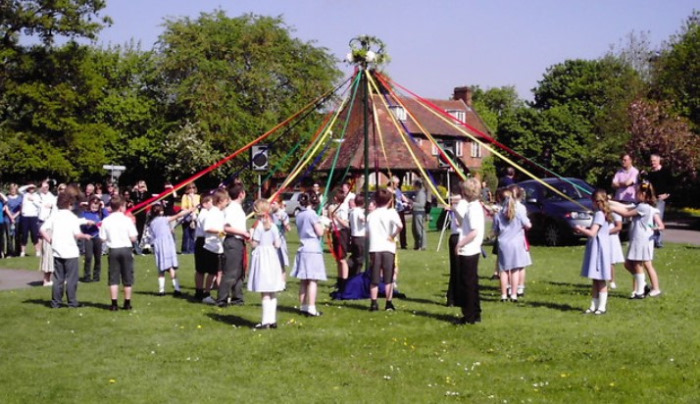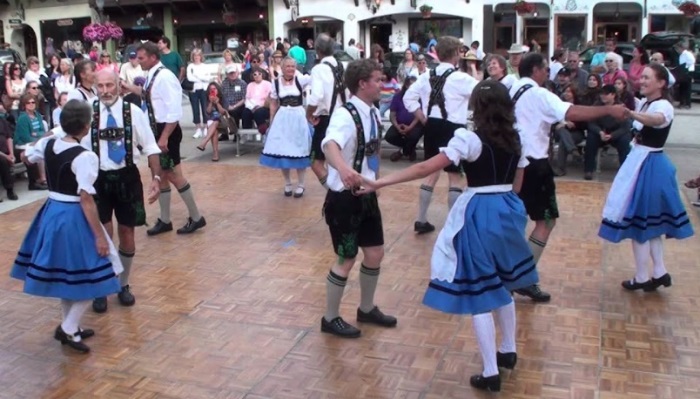Like every other country, Germany has traditional German dances that might not be the best choice if you are going to a nightclub, but certainly, a must-check if we are talking about ballroom and stage dance styles. Powerful and elegant, each of these dances will leave a strong impression on you.
Table of Contents
7 Popular Traditional German Dances
Expressionist

Europe at the beginning of the 20th century was brimming with the growth and development of ballet.
However, many new forms of dance emerged as a protest against the stagnation of nature and the aged society, and the Expressive dance, also known as the Expressionist, was one of the pioneers.
Expressionists toned down remarkably virtuosity and focused more on expressing emotions.
Most part of it is heavily improvisational and provocative, with nearly no rules to restrict the dancer. Isadora Duncan is a very typical example of this style.
Germany had the most obvious and revolutionary changes, partially because the ballet roots there were never too deep. The Expressionist dance here developed to the point of many schools being open with proper education programs.
Mary Wigman, a graduate of one of these schools, was an important figure of the Expressionist with her contributions to dancing, choreographing, and teaching.
Her students, such as Gret Palucca, Jeanna Falk, Hanya Holm, Yvonne Georgi, and more, took her philosophies to the USA.
In 2014, the expressive movements in this modern dance were listed as part of the Intangible Cultural Heritage list of Germany.
Check more: 7 Popular Traditional Cuban Dances
Der Deutsche
“Der Deutsche” (lit: The German) originated in the middle of the 18th century. Many sources pointed back to Bavaria state as the hometown of this dance.
After being performed in several social gatherings, it quickly gained more popularity due to the fun nature of it.
The performers taking part in Der Deutsche would form numerous pairs and move in circles.
At first sight, you might find the dance relatively simple with the ladies spinning around under the men’s guidance, yet it takes a whole lot of effort to ace.
The spinning is quite long, longer than what we usually see in social dances, hence the dancers might get dizzy. When they return to partner work, they have to make sure the transition is not off as well.
Since spinning is an essential part of German dance, the ladies tend to dress up in bell-shaped dresses so the skirt part can spread widely and beautifully. Meanwhile, men usually wear shorts.
Maypole
With traces dating back to 1350 – 1400, the Maypole dance naturally has various origins. Some resources even lead us further into the past with Roman Britain history.
The dance is one of many traditions celebrated on May Day. It begins with a certain type of tree (usually birch), about 8 feet in height, being made into a maypole.
In Germany, they call the maypole “maibaum” and use Bavarian blue and white stripes to paint it. People will set it up in the center of their village and decorate it with ribbons.
The dance includes several steps: The Introductory Dance, The First Plaiting Dance, The Grand Chain, and The Gypsies’ Tent.
Anyone and everyone can take part in the performance, though women take the stage more often.
As for the costumes, the dancers often stick to the tradition of their region because the Maypole dance is more of a folk dance than anything.
However, the unspoken yet general rule is colorful long dresses with ribbons and flowers as accessories.
Schuhplattler
If the theories about Schuhplattler originating from Neolithic times are true, it might be one of the oldest dances that ever appeared on Earth with more than 5000 years of history.
However, we will rely on the evidence from 1030 for now, with a clearer record of a monk describing a dance.
With time, farmers, woodsmen, and hunters all over the Tyrolean Alps and the Bavarian region practiced and refined the dance.
Sometimes, they would change the routine into a dance for couples, yet the core of Schuhplattler is still a “boy’s dance”.
The Schuhplattler we see today comes from the 18th century. Void or rules to follow, the dance was vastly different from other intricately and courtly stylized performances.
Nonetheless, it was still highly appreciated because of the interesting acrobatics.
“Lederhosen” and “dirndls” are compulsory for Schuhplattler. The upper garments and other accessories, like suspenders and knee-length socks, are optional depending on the weather.
Nowadays, you can find contemporary groups dancing to Schuhplattler. Some of them are top-notch clubs. They are not any less skilled than the adult dancers, and their energy can truly get the crowd fired up.
The Ländler
The Ländler dance started getting more popular by the end of the 18th century. It is quite eye-catching with so much stamping and hopping involved.
And since it was originally a folk dance, the music included yodeling aside from pure instruments.
The next century witnessed the rise of dance halls, which turned Ländler into something more elegant and quick-paced. People believe this dance influences the Waltz in numerous ways.
Music for Ländler isn’t rare. A lot of composers wrote for Ländler, including great names like Beethoven and Schubert, hence it’s safe for us to say the music played a crucial role in promoting and maintaining Ländler’s popularity.
Ländler thrives to this day with scenes in TV broadcasts or theatrical plays. If you stumble upon one of them, the choreography is very likely inspired by German and Austrian styles.
The Waltz
You might have seen the name Waltz many times before without being fully aware of its origins, and it means “to turn” or “to roll” in German.
Most veterans strongly believed that Ländler influenced the Waltz, while some pointed out the Waltz was the sped-up variation of Der Deutsche.
The original Waltz featured a choreography for couples – something traditional dances were very unfamiliar with – and the way the man put his arm around the woman was shocking for people of that time. It faced criticism and cancellation and, although it survived, it only became more widely accepted after WWII.
Through all the hardships, the Waltz remained the most popular dance in Germany. It also inspired many ballroom dance styles, which either developed into a whole new dance or turned back into a new variation of the Waltz.
You will typically find female performers of the Waltz in flowy dresses, though not too long that will block the movements. Meanwhile, the gentlemen will also wear formal outfits, preferably in dark colors.
Zwiefacher
Zwiefacher is another Bavarian folk dance, widely recognized for its unique and almost abnormal rhythms. It alternates between 2/4 and 3/4 times with hundreds of patterns composed of only several steps.
Translated directly to “two times”, Zwiefacher might either indicate the time signatures or the way the couple wind against each other so tightly and differently from the traditional poses. In this aspect, it resembles Waltz quite a lot.
In Zwiefacher’s music, the lyrics only act as an assistance to help the dancers memorize the complicated steps, so you will encounter many situations where a melody has different lyrics.
Another detail of diversity about Zwiefacher is that due to being much older than the modern language of Germany, Zwiefacher is known by different names: Neu-Bayerischer, Schweinauer, Übern Fuaß, Grad und Ungrad, and especially Bairischer.
Final Words
Although Germany isn’t exactly famous for having many national dances, there are still traditional German dances with such distinctive details about them that you can’t mistake them for another country.
Some of these dances are region-reliant, yet the internet we freely access today is truly helping to spread the cultural traits and influences to other parts of the nation and even beyond the territory!



